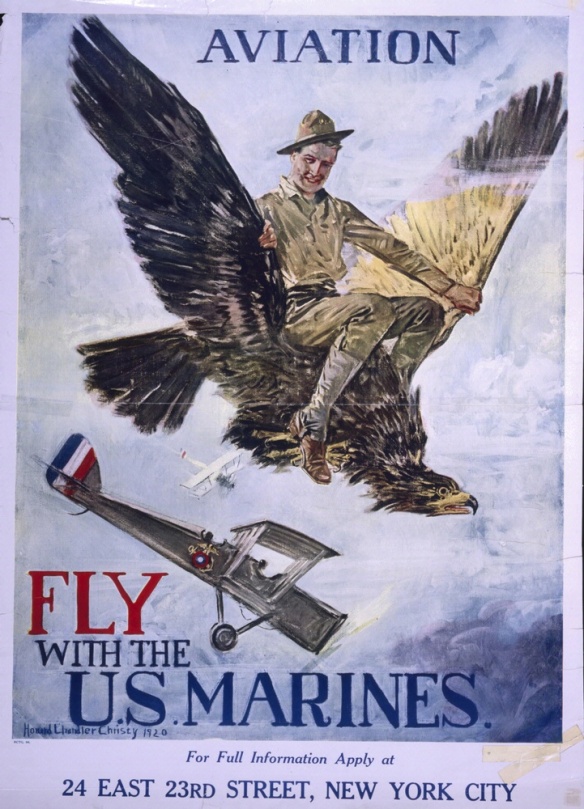Early History of Marine Corps Aviation
May 22, 1912, is considered the birthday of U. S. Marine Corps aviation. It was on that date that a young Marine Corps first lieutenant, Alfred A. Cunningham, reported to the superintendent of the United States Naval Academy in Annapolis, Maryland, for “duty in connection with aviation.” It was the custom of the day for aircraft manufacturers to provide flight instruction, so shortly after arriving in Annapolis, Lieutenant Cunningham was sent to the Burgess Corporation for flight instruction. He was designated Naval Aviator Number 5 on March 4, 1913.
On becoming the Corps’ first aviator, Cunningham joined several other Marine officers to campaign for continued development of Marine Corps aviation. Finally, in February of 1913, he received orders to organize the Corps’ first aviation unit, which was called the Marine Corps Aeronautical Company. This unit, organized at the Philadelphia Naval Yard, had seven officers and forty-three ground personnel.
After World War I broke out in Europe in 1914, Cunningham visited France, where he met the American pilots in the famous squadron known as the Lafayette Escadrille. He also participated in combat flights with French pilots.
After returning from France, Cunningham presented a report of his findings to the commandant of the Marine Corps, helping to further expand Marine aviation. When the United States entered World War I in 1917, Cunningham was directed to organize the First Marine Aviation Force for duty in France. This force was the first Marine aviation unit to ever fly in combat.
Development of Close Air Support
Another date of great historical importance to Marine Corps pilots is July 15, 1927. In what is known as the Second Nicaraguan Campaign, Marines were deployed in Nicaragua to protect American interests during civil strife in that country. On July 15, some Marines came under fire, and, in response, Marine pilots conducted the first of a type of air attack that would come to be called close air support (CAS). From that day forward, the close support of ground combatants would become a governing philosophy of Marine aviation. In the years following the Second Nicaraguan Campaign, Marine pilots worked to perfect the delivery of ordnance close to their counterparts on the ground.
Later Developments in Close Air Support
Precision bombing by aircraft underwent refinement during World War II and the Korean War, and it saw service in the war in Vietnam (1961-1975) and in Operation Desert Storm (1991). During the Korean War, another major philosophical principle emerged in Marine Corps aviation, as the helicopter assumed a large role in medical evacuation, aerial observation, and the delivery of matériel to front-line troops.
From that experience, the Marine Corps, together with the Navy, developed the concept of “vertical envelopment.” They converted some World War II-vintage aircraft carriers to helicopter carriers called LPHs, a term often mistaken to mean “Landing Platform, Helicopter.” The Navy designates amphibious ships with the letter “L” and ships that carry personnel with the letter “P.” Thus, the term “LPH” really means “Amphibious Ship, Personnel, Helicopter.” Today, larger and more efficient naval helicopter carriers support the Marine Corps amphibious forces.
Part of the impetus for developing the concept of vertical envelopment was based on the looming of the atomic age. The naval services, both the Navy and Marine Corps, sought strategies to avoid concentrating in a small beach area troops that could be annihilated with just one nuclear weapon. In the exercise of vertical envelopment, Marine pilots flying helicopters deliver troops from amphibious ships deep into enemy territory, while other Marines land over beaches in more traditional landing craft.
Moreover, Marine pilots in such attack aircraft and helicopters as theAV-8B Harrier and the AH-1W Super Cobra provide troops on the ground with close air support. This mission is additionally important in the landing of Marine forces when the threat of mechanized counterattack exists. Marine mechanized and anti-mechanized units may not land early in an amphibious operation, and Marine infantry depend on aircraft to play this role in the opening phase of an assault.
Finally, Marine pilots in fighter aircraft can conduct operations to protect the beachhead and landing zones from attack by enemy aircraft. In fact, the main mission of the KC-130 aircraft that some Marine pilots fly is to refuel such fighter aircraft for sustained operations or for moving long distances.
